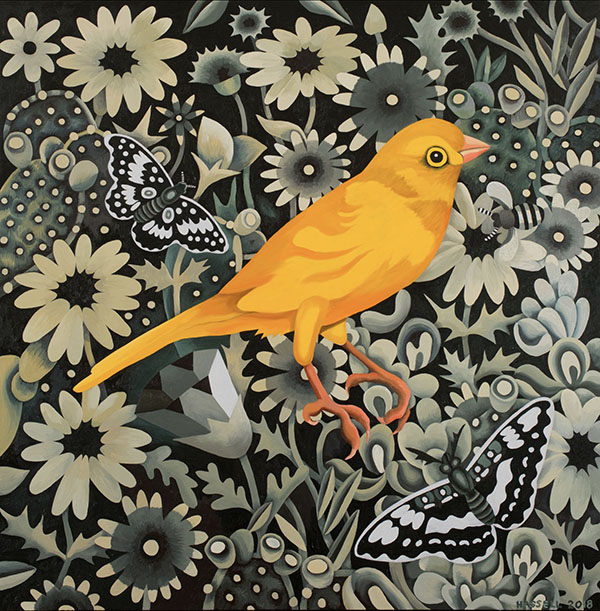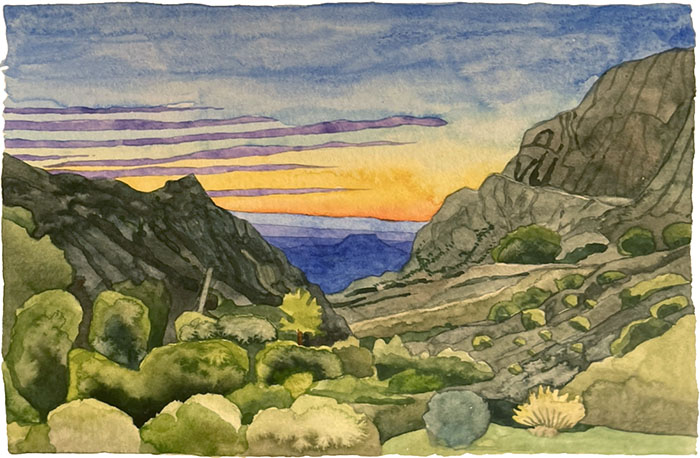Silver Linings: Being an Artist in the Midst of a Pandemic


The beginning of the Covid outbreak was terrifying and confusing largely due to conflicting information in the media. Everything stopped. Literally. With orders of "lockdown" or its alternative euphemism, "sheltering in place," people began to spend time at home in relative isolation. Businesses closed. And a long period of social distancing and physical isolation began.
As an artist I felt the alarm but I didn't feel particularly affected from a practical perspective. I was used to working alone in my studio and I was able to continue working without any perceptible interruption. It was, in fact, a kind of a weirdly refreshing break from the crazy momentum of life with deadlines that we, in large part, create for ourselves, with help, of course, from the media that always perpetuates urgency along with its usual pedaling of poisons and alternatively the pedaling of cures. In spite of my "practical perspective" and its accompanying optimism, there was another, more subtle but deeply resonant anxiety that I believe was a response to the collective fear and enforced isolation imposed upon us all.
As is my way, when confronted with stress or difficulties of almost any kind, I delved deeper into my art. It is my refuge as I suspect it is for many, if not most, artists. And I felt a little guilty for that with all the sorrow going on the world—the loss of loved ones, the loss of jobs and livelihoods and the loss of companionship. But I believe in the power of positive action, of turning what might appear to be a terrible situation into something positive, to find some kind of "silver lining."
My work has always been about nature. It has been inspired by nature and driven by my fundamental belief that we "are nature," not separated from it. My own form of contemplation, a requirement of self-awareness and self-re-evaluation, has led me to consider more deeply our collective relationship to nature especially faced with the rapidly accelerating conditions of climate change. We humans aren't responsible for climate change, but the world we have fashioned to serve our needs and our insistent reliance on fossil fuels and other resources, along with our unwillingness to give up the comforts we consider essential, have led to a kind of denial of responsibility and environmental negligence.

I have never held to the belief that art should necessarily have a "political" or a "social" message. I do believe art should represent some kind of self-awareness, personally and collectively. It should be honest and reflect an awareness of the world around us, the larger community. I have believed that art should exist for its own sake. I have believed it should be self-reflective and if it's authentic in its intention the rest will take care of itself. In other words, it needn't "beat the viewer over the head" with a message but rather be mindful and, in turn, suggestive. It should provide the beginning of a dialogue or continue a dialogue and manifest itself as a form of communication.
Along this line of thinking, in what I would consider to be a contemplative frame of mind, driven as much by intuition as rationale, I began to think of ways to find visual parallels between extinct and vanishing species of wildlife and formal elements of art. Birds, in particular, and pollinators of various kinds represent key participants in this beautiful web of life that we are inextricably a part of.
Thinking of birds and the environment made me think of Kurt Vonnegut's canary in the coal mine theory of art* wherein artists are the "canaries" in a world becoming toxic. Besides being inspired by nature my work has always also been about color. Reducing my color palette provided a good parallel for me, symbolically comparing a world without birds and insects and animals and all the associated flora to a world without color (or a very reduced spectrum of color).

Authentic Art has always reflected culture and artists have often been the reflectors of that culture and harbingers of things to come. While pursuing my own path, which I admit often feels self-indulgent in spite of aspiring to something more universal, I realize my objectives are not unique. All true artists seek something deeper than mere visual entertainment or self-aggrandizement. Art can and should be a form of collective communication through a mostly wordless medium. I also believe, personally, that art should connect people, that by the very nature of its visual and physical presence, it requires interactivity. It sets up a dialogue or a kind of "call and answer." I think a work of art, like a work of poetry, is completed when viewed in much the same way that a poem is completed when it is read or heard. Both are interactive. My hope is that it connects not just to one but to a community. Communities begin with one making two.
We are all affected by a pandemic. I am grateful to remain part of a larger community adapting to different forms of communication and connectivity. I am comforted in knowing that I am a small part of a larger voice and that I have the means to express, in some measure, the aspirations of many.
Due to Covid-19, my recent exhibition at the Old Jail Center in Albany, Texas, was postponed several months. Titled Penumbra, it invoked that partially shaded outer region of a shadow cast by an opaque object. In astronomy, the word "penumbra" refers to the shadow cast by the earth or moon over an area experiencing a partial eclipse. Both definitions relate to the work selected for the show in both poetic and literal ways. The works look shadowy due to the reduction of color, as if the world has been eclipsed in some way, which it has. Metaphorically, they represent shadowy regions of our world—a transitional space between what is true and what is perceived. It's not strictly darkness but the place where darkness and light meet. Where the silver linings are.

* My painting Canary (In the Coal Mine) was inspired by a quote from Kurt Vonnegut referring to artists and the role of art: "I sometimes wondered what the use of any of the arts was. The best thing I could come up with was what I call the canary in the coal mine theory of the arts. This theory says that artists are useful to society because they are so sensitive. They are super-sensitive. They keel over like canaries in poison coal mines long before more robust types realize that there is any danger whatsoever."
Native Texan Billy Hassell has been making nature inspired paintings, lithographs and watercolors for more than 40 years. His colorful and expressive art, frequently featuring birds and indigenous plants and animals of Texas and the Gulf Coast region and mindful of conservation and the environment have been exhibited nationwide and are included in the permanent collections of museums throughout Texas.